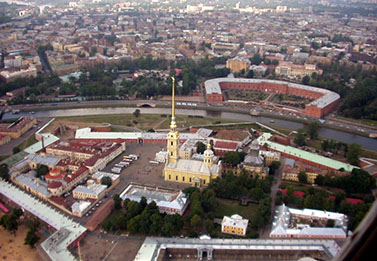Peter and Paul Fortress in St Petersburg

For more than three hundred years Saint Petersburg has stood on the banks of the Neva River.
The city was founded on the ancient trade route that has for centuries connected the East and West.
In the ninth century the lands around the Neva were conquered by the ancient Russian State, and from the thirteenth century a long-lasting battle was fought over the ownership of this territory.
During the Northern War of 1700-1721 these lands were recaptured from Sweden, and a fortress was built to protect them. Flat Hare Island (Zayachy) was chosen by Peter the Great as the site for this fortress because of its strategic position and small size.
The new fortress, and the town that surrounded it, was named Saint Petersburg in honour of Peter’s patron saint. The fortress was founded on 27 May, 1703, a date which has become the city’s birthday.
On the 29 June, 1703, the day of the Apostles Peter and Paul, the Tsar’s name-day was solemnly celebrated. In the center of the fortress a cathedral was consecrated in the name of the Holy Apostles Peter and Paul. The fortress was named Peter and Paul Fortress after the cathedral.
Peter and Paul Fortress was first built of earth and later rebuilt in stone. The work was finished only in 1738, after the war had already been won. The shape of the fortress reflects the shape of the island on which it stands. It consists of six bastions, each after the associates of Peter the Great who supervised the construction of them. The bastions of Peter and Paul Fortress are connected by two parallel walls filled with earth and crushed stone. Deep inside the walls, hollows were left to house the casemates of the local garrison.
Later two ravelins, fortifications which were to protect the fortress from the rear and sides, were added to the main structure. They were separated from the fort by moats which were filled in in the nineteenth century.
There are six gates through the walls of Peter and Paul Fortress. The main one is St. Peter’s Gate and was designed by the architect Trezzini. It’s decorated with a wooden bas-relief, “The Precipitation of Simon Magus by Apostle Peter”, which allegorically represents Russia’s victory over Sweden and Saint Petersburg’s invincibility. Below this there is a huge sculpture of the double headed eagle, the national emblem of Russia.
Close to the Neva Gate, facing the River Neva, is Naryshkin bastion where two cannon fire daily at midday, a tradition of Peter’s time which helped people know exactly what time it was.
Saint Peter and Paul Cathedral is a magnificent example of eighteenth century architecture, taking baroque and classical influences from all over Europe. No Orthodox churches like this had been in Russia before Peter the Great. Its exterior is imposing and majestic, and the building has a multilevel belfry capped by a needle-thin steeple with an angel on the top.

The Cathedral’s gilt spire dominates St. Petersburg’s skyline, and, at 122.5 metres tall, it is still the tallest building in St. Petersburg.
Before the reign of Peter the Great, the Cathedral of the Archangel Michael in Moscow’s Kremlin served as a necropolis for Russia’s Princes and Tsars. When St. Petersburg became the new capital this role passed to Saint Peter and Paul Cathedral, meaning it is the burial place of the Russian Imperial family. Peter the Great himself is buried near the southern entrance. In July 1998 the remains of Nicholas the Second, the last Russian Tsar, and his family were brought here.
In the eighteenth century, when Peter and Paul Fortress lost its military importance, it was turned into a jail. People who were accused of plotting against the regime and those who fought against autocracy were imprisoned there. The fortress’s guns never saw any action and were used as a flood warning signal.
Special buildings like the engineer’s house, which was used as the offices of engineering department, were built on the island in the middle of the eighteenth century.
The commandant’s house used to be the residence of all the commandants of Peter and Paul Fortress. It also housed the office of the fortress and the courtroom in which prisoners’ cases were heard.
As you come out of St. Peter and Paul Cathedral you can see opposite you the original, yellow-white building of the Mint, decorated by a pediment.
The Mint was founded in 1724 and was initially based in Trubetskoi bastion. The new building was constructed in 1802 and at that time it was the only place in the country where money could be coined. Here at the Mint, in 1811, the first lever press in the world for coining money was built. The principle of its invention is still used at mints throughout the world. The mint currently produces small change and makes orders, medals and badges of all kinds.
Outside the southern wall of St. Peter and Paul Cathedral there is a monument to the founder of Saint Petersburg. This statue shows him in an unusual way; he is portrayed as being very tall with a small unwigged head and strong, long-fingered hands. This modern artist’s interpretation doesn’t match the eighteenth century ideas of Peter’s Italian sculptor, whose wax statue Michail Shemyakin copied, but leaves a field for thinking over the personality of Peter the Great, the eminent statesmen, reformer, educator, military leader and diplomat. In 1703 Peter the Great founded Saint Petersburg, a city which became the capital of the Russian Empire in 1712.
Read more
- How to travel in Saint Petersburg without living your home
- Four of the ten best restaurants in the country are in St. Petersburg
- The first Holocaust museum in St. Petersburg
- A scientist from St. Petersburg created the biochronicle of Peter the Great.
- 10 interesting facts about Saint-Petersburg streets

Moderate 2 Day
Shore Excursion
St. Petersburg, Russia
from 241$